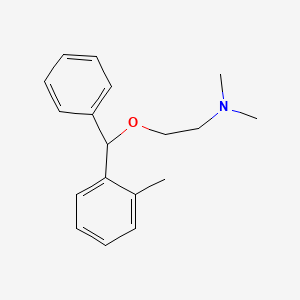Attribution Statement: LactMed is a registered trademark of the U.S. Department of Health and Human Services.
NCBI Bookshelf. A service of the National Library of Medicine, National Institutes of Health.
Drugs and Lactation Database (LactMed®) [Internet]. Bethesda (MD): National Institute of Child Health and Human Development; 2006-.
CASRN: 83-98-7

Drug Levels and Effects
Summary of Use during Lactation
No published information is available on the use of orphenadrine during breastfeeding. Manufacturer’s estimates indicate that the amount in milk may be low. The drug’s anticholinergic activity might interfere with milk production. An alternate agent may be preferred.
Drug Levels
Maternal Levels. A European manufacturer of orphenadrine estimated that with a maternal dose of 150 mg, milk orphenadrine concentration would be about 300 to 400 mcg/L.[1] This implies that the relative infant dosage might be about 1.8 to 2.4% of the mother’s weight-adjusted dosage.
Infant Levels. Relevant published information was not found as of the revision date.
Effects in Breastfed Infants
Relevant published information was not found as of the revision date.
Effects on Lactation and Breastmilk
Orphenadrine has anticholinergic activity. Anticholinergics can inhibit lactation in animals, apparently by inhibiting growth hormone and oxytocin secretion.[2-6] Anticholinergic drugs can also reduce serum prolactin in nonnursing women.[7] The prolactin level in a mother with established lactation may not affect her ability to breastfeed.
References
- 1.
- Chaplin S, Sanders GL, Smith JM. Drug excretion in human breast milk. Adv Drug React Ac Pois Rev 1982;1:255-87.
- 2.
- Aaron DK, Ely DG, Deweese WP, et al. Reducing milk production in ewes at weaning using restricted feeding and methscopolamine bromide. J Anim Sci 1997;75:1434-42. [PubMed: 9250502]
- 3.
- Powell MR, Keisler DH. A potential strategy for decreasing milk production in the ewe at weaning using a growth hormone release blocker. J Anim Sci 1995;73:1901-5. [PubMed: 7592071]
- 4.
- Daniel JA, Thomas MG, Powell MR, et al. Methscopolamine bromide blocks hypothalmic-stimulated release of growth hormone in ewes. J Anim Sci 1997;75:1359-62. [PubMed: 9159285]
- 5.
- Bizzarro A, Iannucci F, Tolino A, et al. Inhibiting effect of atropine on prolactin blood levels after stimulation with TRH. Clin Exp Obstet Gynecol 1980;7:108-11. [PubMed: 6788407]
- 6.
- Svennersten K, Nelson L, Juvnäs-Moberg K. Atropinization decreases oxytocin secretion in dairy cows. Acta Physiol Scand 1992;145:193-4. [PubMed: 1636447]
- 7.
- Masala A, Alagna S, Devilla L, et al. Muscarinic receptor blockade by pirenzepine: Effect on prolactin secretion in man. J Endocrinol Invest 1982;5:53-5. [PubMed: 6808052]
Substance Identification
Substance Name
Orphenadrine
CAS Registry Number
83-98-7
Drug Class
Breast Feeding
Lactation
Milk, Human
Antiparkinson Agents
Cholinergic Antagonists
Muscle Relaxants, Central
Parasympatholytics
Muscarinic Antagonists
Disclaimer: Information presented in this database is not meant as a substitute for professional judgment. You should consult your healthcare provider for breastfeeding advice related to your particular situation. The U.S. government does not warrant or assume any liability or responsibility for the accuracy or completeness of the information on this Site.
- User and Medical Advice Disclaimer
- Drugs and Lactation Database (LactMed) - Record Format
- LactMed - Database Creation and Peer Review Process
- Fact Sheet. Drugs and Lactation Database (LactMed)
- Drugs and Lactation Database (LactMed) - Glossary
- LactMed Selected References
- Drugs and Lactation Database (LactMed) - About Dietary Supplements
- Breastfeeding Links
- PubChem SubstanceRelated PubChem Substances
- PubMedLinks to PubMed
- Investigation of 4-methyldiphenhydramine hydrochloride, N,N-dimethyl-2-[(p-methyl-alpha-phenylbenzyl)oxy]ethylamine hydrochloride.[Pharm Weekbl. 1967]Investigation of 4-methyldiphenhydramine hydrochloride, N,N-dimethyl-2-[(p-methyl-alpha-phenylbenzyl)oxy]ethylamine hydrochloride.Doorenbos HJ, de Roos AM, Nauta WT. Pharm Weekbl. 1967 Dec 15; 102(50):1331-6.
- Salicylic acid plasma levels following multiple doses of Norgesic Forte and aspirin.[Ther Drug Monit. 1983]Salicylic acid plasma levels following multiple doses of Norgesic Forte and aspirin.Harrison LI, Kehe CR, Goldlust MB, Kvam DC, Bianchine JR. Ther Drug Monit. 1983; 5(4):401-4.
- Gas chromatographic determination of (o-methyl-alpha-phenylbenzyloxy)acetic acid levels in human serum following therapeutic doses of orphenadrin (Disipal).[J Chromatogr. 1979]Gas chromatographic determination of (o-methyl-alpha-phenylbenzyloxy)acetic acid levels in human serum following therapeutic doses of orphenadrin (Disipal).Huisman J, Liebregt LL, Thyssen JH. J Chromatogr. 1979 Dec 1; 164(4):510-4.
- Review Glycopyrrolate.[Drugs and Lactation Database (...]Review Glycopyrrolate.. Drugs and Lactation Database (LactMed®). 2006
- Review Prilocaine.[Drugs and Lactation Database (...]Review Prilocaine.. Drugs and Lactation Database (LactMed®). 2006
- Orphenadrine - Drugs and Lactation Database (LactMed®)Orphenadrine - Drugs and Lactation Database (LactMed®)
- cytochrome oxidase subunit 1, partial (mitochondrion) [Apanteles aluella]cytochrome oxidase subunit 1, partial (mitochondrion) [Apanteles aluella]gi|1530798539|gb|AZJ37420.1|Protein
Your browsing activity is empty.
Activity recording is turned off.
See more...
